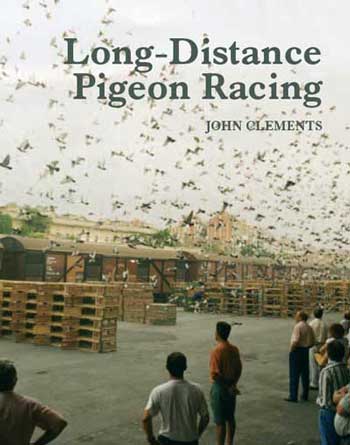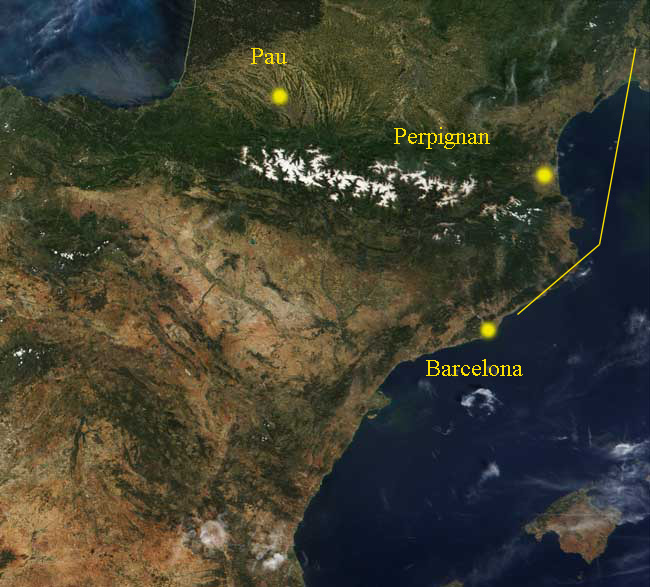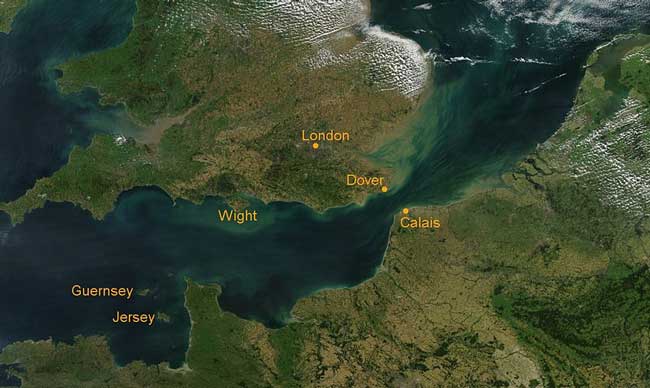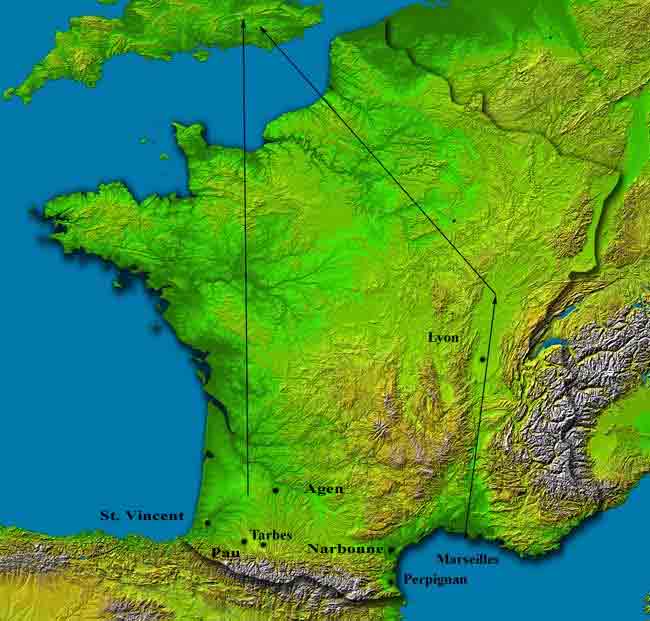
Copyright © 2014 by Nigel Lane All Rights reserved.

The International Trail
Where do we begin?
It’s always difficult when starting out on a new venture to know exactly where and how to begin. There are some excellent books available, like Long Distance Pigeon Racing by John Clements, which give an insight into how the champions succeed but what of the beginner? The sport of pigeon racing does not provide us with a comprehensive training scheme, or some sort of advice centre or even a set of DIY books we can refer to. So we are all left very much to our own devices. I suppose the first thing you need to know is what are the challenge’s involved? How does International racing differ from any other area of pigeon racing?
Where do we begin?
It’s always difficult when starting out on a new venture to know exactly where and how to begin. There are some excellent books available, like Long Distance Pigeon Racing by John Clements, which give an insight into how the champions succeed but what of the beginner? The sport of pigeon racing does not provide us with a comprehensive training scheme, or some sort of advice centre or even a set of DIY books we can refer to. So we are all left very much to our own devices. I suppose the first thing you need to know is what are the challenge’s involved? How does International racing differ from any other area of pigeon racing?
What are the International's?
The Western European International programme, which has built up over many years, was pioneered, organised and is still administered by the premier Belgian Societies. Time has brought more and more nations to join the challenge which today provides the largest and most competitive series of long distance pigeon races in the world.
The four most prestigious races are:
PAU International organised by La Colombe Joyeuse
BARCELONA International organised by the Cureghem-Centre
MARSEILLES International organised by Club de Fond Wallonie
PERPIGNAN International organised by Entente Belge
These form the core of the programme and from them also comes the “Europa Cup”, probably the most prestigious award in the Racing Pigeon sport. This is awarded to the best average, across these four highly prestigious races, from two nominated pigeons in each race, the top two pigeons shown on the entry form. The “Europa Cup” competition reflects not simply the best performing pigeons but the fancier’s selection ability as well as the quality and consistency of the loft.
There have been other International Races in the programme and at present three others are included. While Tarbes stood for several years the racepoint has recently been changed to St. Vincent, then there is Narbonne and finally the most recent but increasingly popular Bordeaux, as it is generally know although actually raced from Agen.
In order to ensure the long distance element of competition each race has a minimum qualifying distance. The inevitable but unfortunate consequence of this is that large parts of France and Germany are excluded from most if not all races. Although the Marseille distance has recently changed it remains the shortest of the Europa Cup races but mainly due to its more easterly location it does allow some competitors from western France to participate.
The principal countries involved are of course Belgium and Holland but large entries are also made by France and Germany. Luxembourg also contributes well proportionate to its size and while the UK has made an entry over many years it has not yet established the size that it should. Entries have also been made in recent years from countries more to the east of Europe, Poland in particular, and it is hoped that this pattern will continue into the future.
Apart from anything else this provides us with two important facts - all the races are long distance and competition is drawn from the strongest racing pigeon countries in the world. If you don’t feel too daunted by this lets have a closer look at what these races entail.
The Western European International programme, which has built up over many years, was pioneered, organised and is still administered by the premier Belgian Societies. Time has brought more and more nations to join the challenge which today provides the largest and most competitive series of long distance pigeon races in the world.
The four most prestigious races are:
PAU International organised by La Colombe Joyeuse
BARCELONA International organised by the Cureghem-Centre
MARSEILLES International organised by Club de Fond Wallonie
PERPIGNAN International organised by Entente Belge
These form the core of the programme and from them also comes the “Europa Cup”, probably the most prestigious award in the Racing Pigeon sport. This is awarded to the best average, across these four highly prestigious races, from two nominated pigeons in each race, the top two pigeons shown on the entry form. The “Europa Cup” competition reflects not simply the best performing pigeons but the fancier’s selection ability as well as the quality and consistency of the loft.
There have been other International Races in the programme and at present three others are included. While Tarbes stood for several years the racepoint has recently been changed to St. Vincent, then there is Narbonne and finally the most recent but increasingly popular Bordeaux, as it is generally know although actually raced from Agen.
In order to ensure the long distance element of competition each race has a minimum qualifying distance. The inevitable but unfortunate consequence of this is that large parts of France and Germany are excluded from most if not all races. Although the Marseille distance has recently changed it remains the shortest of the Europa Cup races but mainly due to its more easterly location it does allow some competitors from western France to participate.
The principal countries involved are of course Belgium and Holland but large entries are also made by France and Germany. Luxembourg also contributes well proportionate to its size and while the UK has made an entry over many years it has not yet established the size that it should. Entries have also been made in recent years from countries more to the east of Europe, Poland in particular, and it is hoped that this pattern will continue into the future.
Apart from anything else this provides us with two important facts - all the races are long distance and competition is drawn from the strongest racing pigeon countries in the world. If you don’t feel too daunted by this lets have a closer look at what these races entail.
The long and the short.
All the International races are over a long distance but it is not just the distance that presents a challenge, just look at the territory
All the International races are over a long distance but it is not just the distance that presents a challenge, just look at the territory
The map of French release points above, I hope, shows just what a formidable obstacle the landscape sets. Looking at it from a British perspective, and purely in terms of landscape, there is no doubt that both Tarbes and Pau offer a more straightforward route home. I was tempted to say easier but at 500 miles plus easy is not an appropriate description. Hopefully, with the right wind, they will fly straight up the western side of France, taking the longer channel crossing, and then race for home. Not only do these two race points offer a more straightforward route to the UK but they also present a slightly more difficult route to Belgium, Holland and Germany.

Looking at Perpignan, Narbonne, Marseilles and beyond them into Spain and Barcelona it becomes clear that they present quite the opposite. Not only are they all further but Perpignan and Marseille sit on opposite sides of the Gulf of Lions straddling the estuary of the great river Rhone. Over many centuries the Rhone has carved out a grand valley through this mountainous region which stretches north east to Lyon and leads straight on to Belgium and Holland. So once the pigeons are liberated from Perpignan or Marseille, or have swept round the Costa Brava from Barcelona, and set themselves on the general direction for home they are confronted by the towering heights of the Alpes du Dauphine to the east and the Massive Central to the west. This must appear as an insuperable problem but then, rather invitingly, they see laid out before them the low, flat marshes of the Carmargue which reach into the welcoming, beckoning, all embracing arms of the Rhone Valley itself. What other route would they want to take? So on they rush into the valley and, once committed to this course, they have to follow it through all the way up to Lyon and beyond before they have any hope of finding a suitable break in the hills to turn north west. This enforced dogleg adds distance to an already very long journey for our pigeons while their competitors are set up on the line for home. So while on two races the UK may have a slight advantage on the other three races we are at a distinct disadvantage.
What a drag.
The mountainous land is not the only obstacle our pigeons will have to overcome, and perhaps not even the hardest, because the other huge impediment is the competition. As can be seen amongst the other participants are Belgium, France, Germany and Holland, but what is the numbers of pigeons they send. At Dax 2003, not only the year the race was won in the UK but the year when we, the U.K., sent far more pigeons to a race than usual, the numbers sent were Belgium 5,023, Germany 2,445, Holland 9,404 and France 1,340 with the UK contingent consisting of 1,188 pigeons. This was a brilliant turn out for UK pigeons, which I hope we may equal or even better in another year, because in the past, and at other races, we have sent far fewer. At Perpignan 2003 for instance the numbers were Belgium 7,479, Holland 5,883, Germany 2,151, France 1,638 and even little Luxembourg mustered 101 while we could only manage 78. Combine this with the fact that Dax, because it did not have the prestige of the other Internationals, did not attract as large an entry from the main pigeon nations and you can see that the effects of any drag are not going to be coming our way.
The channel and the weather.
The weather conditions, apart from the wind, will be the same for all I suppose but it is likely to be hot. The heat can be scorching in the south of France and this will take its toll unless the pigeons are properly prepared. One bit of weather that will effect only the UK pigeons though is that around the channel. I don’t think the water itself should present problems because any pigeons being sent to an International race should have overcome this obstacle on several occasions before. While pigeons show some reluctance to cross water, once they have experience and when they have had a good fly before meeting it and looking at the race times they put up, one can only assume they come across with little hesitation. The weather at the channel though can make it a very different proposition. This small stretch of sea is its own little world and can produce fogs and mists at the drop of a hat. These conditions will not be part of the liberators considerations even if they could be forecast, which often they cannot, so this is another possible impediment to the UK birds.
What a drag.
The mountainous land is not the only obstacle our pigeons will have to overcome, and perhaps not even the hardest, because the other huge impediment is the competition. As can be seen amongst the other participants are Belgium, France, Germany and Holland, but what is the numbers of pigeons they send. At Dax 2003, not only the year the race was won in the UK but the year when we, the U.K., sent far more pigeons to a race than usual, the numbers sent were Belgium 5,023, Germany 2,445, Holland 9,404 and France 1,340 with the UK contingent consisting of 1,188 pigeons. This was a brilliant turn out for UK pigeons, which I hope we may equal or even better in another year, because in the past, and at other races, we have sent far fewer. At Perpignan 2003 for instance the numbers were Belgium 7,479, Holland 5,883, Germany 2,151, France 1,638 and even little Luxembourg mustered 101 while we could only manage 78. Combine this with the fact that Dax, because it did not have the prestige of the other Internationals, did not attract as large an entry from the main pigeon nations and you can see that the effects of any drag are not going to be coming our way.
The channel and the weather.
The weather conditions, apart from the wind, will be the same for all I suppose but it is likely to be hot. The heat can be scorching in the south of France and this will take its toll unless the pigeons are properly prepared. One bit of weather that will effect only the UK pigeons though is that around the channel. I don’t think the water itself should present problems because any pigeons being sent to an International race should have overcome this obstacle on several occasions before. While pigeons show some reluctance to cross water, once they have experience and when they have had a good fly before meeting it and looking at the race times they put up, one can only assume they come across with little hesitation. The weather at the channel though can make it a very different proposition. This small stretch of sea is its own little world and can produce fogs and mists at the drop of a hat. These conditions will not be part of the liberators considerations even if they could be forecast, which often they cannot, so this is another possible impediment to the UK birds.

No Blinkers.
Winning the Europa Cup from the UK would be some triumph indeed. We know now, since 2003 and 2004, that Dax can be won in the UK and from 2011 both Pau and Bordeaux but winning any of the others would be a giant leap. A realistic target for anybody contemplating these races is not going to be an International win, not that we shouldn’t set out to try, because the chances are rather slim so we must look to other measures to judge success. Clearly a UK win would be a high level target and achievement but location will have a great effect on even this and so we need to look at relative performances. I read an article some time back by Derrick Cutcliffe, concerning International results in which he mentioned that:-
“some of the “prizes won” appear to be astronomically low. I note two at over 4000th, several over 3000th and others at over 2000th. Cogitating upon that it occurred to me that some old unforgiving fanciers whom I have known would have been heading up to the back garden with a determined look and a shovel when notified of results of that sad and sorry magnitude.”
While I have the greatest respect for Derrick Cutcliffe I think in this area he has it wrong. For me one of the highlights of the 2003 season, for instance, was John Clements performance from Dax. He has been going on for years about the one in four pools and the implications, which go way beyond just pool money, with few taking any notice. Then his brave little hen was 4,457th Open Dax International from an entry of 19,420 pigeons and best of all she was 653rd from 3938 hens winning 1000 in the MISE, that’s a whole 10 Euro. For me the best 10 Euro value in the whole race. It was a great performance because although she was not the furthest flying pigeon she was flying a long way further than the vast majority and to win pool money as well, in Stockport, at 650 miles was a great achievement. When you take to International racing you have to free yourself from that rather blinkered concept, only first counts, and take a wider and more detailed examination of performance.
They’re off.
So what you need then, to fly the Internationals, is pigeon’s that can fly 500-700 miles and more depending on your location, pigeons that are not daunted by mass liberations up to 20,000 - 30,000 birds at times, pigeons that can hold their own with a drag that is taking them off their line and break from that drag when opportunity arises, pigeons that can then make it on their own over very long distances and finally pigeons that can deal with the extremes of heat likely to be found at liberation and the mists and water at the Channel plus the rain in the UK. Simple really, the greater the challenge the greater the satisfaction, so why don’t you take up the challenge and seek the satisfaction?
Winning the Europa Cup from the UK would be some triumph indeed. We know now, since 2003 and 2004, that Dax can be won in the UK and from 2011 both Pau and Bordeaux but winning any of the others would be a giant leap. A realistic target for anybody contemplating these races is not going to be an International win, not that we shouldn’t set out to try, because the chances are rather slim so we must look to other measures to judge success. Clearly a UK win would be a high level target and achievement but location will have a great effect on even this and so we need to look at relative performances. I read an article some time back by Derrick Cutcliffe, concerning International results in which he mentioned that:-
“some of the “prizes won” appear to be astronomically low. I note two at over 4000th, several over 3000th and others at over 2000th. Cogitating upon that it occurred to me that some old unforgiving fanciers whom I have known would have been heading up to the back garden with a determined look and a shovel when notified of results of that sad and sorry magnitude.”
While I have the greatest respect for Derrick Cutcliffe I think in this area he has it wrong. For me one of the highlights of the 2003 season, for instance, was John Clements performance from Dax. He has been going on for years about the one in four pools and the implications, which go way beyond just pool money, with few taking any notice. Then his brave little hen was 4,457th Open Dax International from an entry of 19,420 pigeons and best of all she was 653rd from 3938 hens winning 1000 in the MISE, that’s a whole 10 Euro. For me the best 10 Euro value in the whole race. It was a great performance because although she was not the furthest flying pigeon she was flying a long way further than the vast majority and to win pool money as well, in Stockport, at 650 miles was a great achievement. When you take to International racing you have to free yourself from that rather blinkered concept, only first counts, and take a wider and more detailed examination of performance.
They’re off.
So what you need then, to fly the Internationals, is pigeon’s that can fly 500-700 miles and more depending on your location, pigeons that are not daunted by mass liberations up to 20,000 - 30,000 birds at times, pigeons that can hold their own with a drag that is taking them off their line and break from that drag when opportunity arises, pigeons that can then make it on their own over very long distances and finally pigeons that can deal with the extremes of heat likely to be found at liberation and the mists and water at the Channel plus the rain in the UK. Simple really, the greater the challenge the greater the satisfaction, so why don’t you take up the challenge and seek the satisfaction?

Seneca
It is not because things are difficult that we do not dare, it is because we do not dare that they are difficult.
It is not because things are difficult that we do not dare, it is because we do not dare that they are difficult.



